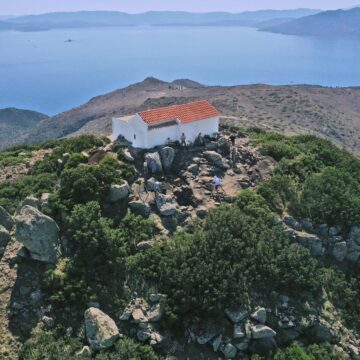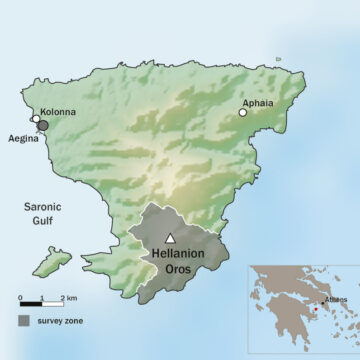Swiss-Greek excavation of the sanctuary of Zeus on the island of Aegina
From the top of Hellanion Oros, the highest mountain of Aegina, one can enjoy a panoramic view of the Aegean Sea, the Peloponnese and the Attic coastline. It is at this site, nowadays crowned by a small Orthodox chapel, that ancient literary sources place the sanctuary of Zeus Hellanios, established by the god’s son, Aiakos. During the 20th century, German archaeologists identified and excavated research on the slopes of the mountain a large complex associated with the cult of Zeus without, however, locating the temple and its altar. Subsequently, researchers turned their attention towards the summit of the mountain, which was also the find spot of a Mycenaean terracotta figurine (c. 1400-1200 BC), exhibited in the Archaeological Museum of the island.
While the view from the summit is breathtaking, the excavation is demanding; researchers of the Swiss School of Archaeology in Greece (ESAG) and the Ephorate of Antiquities of Piraeus and Islands, as well as Swiss, Greek and German students, climb up the steep mountainside to work under the wind gusts battering the summit. The efforts, however, quickly paid off with the discovery in 2023 of a Bronze Age building just below the foundations of the chapel.
The Team
The excavation is directed by Tobias Krapf, Swiss School of Archaeology in Greece (ESAG), and Stella Chryssoulaki, former Director of the Ephorate of Antiquities of Piraeus and Islands, now General Director of the Heraklion Archaeological Museum. The Swiss School is the only permanent Swiss archaeological mission outside of Switzerland. It functions as an inter-university academic and research centre. Every year, many students from Swiss universities participate in excavations and museum internships, particularly on the island of Euboea, where Swiss archaeologists have been working since the 1960s.
A place of refuge
In a room measuring 13m2, more than 30 vases, some broken and others intact, dating to the Late Mycenaean period (c. 1300-1100 BC) were discovered. Most of the pottery consists in cooking pots, as well as dining and drinking vessels. Bronze, stone and other clay artifacts were also found in the same area. While these objects are not votive in character, they seem to indicate that, at the end of the Mycenaean period, during the unsecure times of the collapse of the Mycenaean palaces, some of the island’s inhabitants found refuge at the top of the mountain. The remains of a prehistoric fortification are still visible today on its western slope and one cannot exclude the possibility of the Bronze Age building found in 2023 being part of the same architectural complex. This discovery does not deny the existence of a cult before the construction of the building. The slightly older Mycenaean figurine from the site strongly hints towards this direction, while pottery dating back to the first half of the second millennium BC has also been discovered, opening the way for further research at this location.

Pots from the destruction of the Mycenaean building
The first traces of cult
Traces of the cult of Zeus dating to the first millennium BC and the first centuries AD have been found on the summit of Hellanion Oros. A foundation made of massive stone blocks next to the chapel, together with the discovery of ancient roof tiles, indicate that an older building, possibly a temple, was located beneath the small church.
A little further down, above the prehistoric structures, excavations also revealed the remains of sacrifices. After the sacrificial rituals on the altar, which was probably at the top of the mountain the ashes and burnt animal bones were thrown down the slope. For archaeologists, these deposits, containing thousands of small bone fragments, are of great interest, as they enable them to reconstruct the rituals that took place in Antiquity. The discovery of Roman oil lamps indicates that the cult could also have taken place at night.
Two distinct aspects of the mountain thus attracted men and women since the Bronze Age: on one side, the security provided by the isolated and not easily accessible location, and on the other, its dominant position which led to its consecration to Zeus.
The cult of Zeus Hellanios
It’s hardly surprising that the highest peak on the island of Aegina is dedicated to Zeus, ruler of the gods and the heavens. According to the ancient writer Pausanias, the cult was established on the island by Zeus’ son, on the recommendation of the oracle at Delphi, when Greece was in the grip of a drought. Similarly, in the 4th to 3rd centuries BC, Theophrastus described in a text on meteorological phenomena that the presence of numerous clouds above the mountain of Zeus Hellanios in Aegina was a sign of heavy rain. Until now, peak sanctuaries are known mainly from research carried out on the island of Crete, but various projects, including the Swiss-Greek campaign on Aegina, are now bringing to light similar discoveries in mainland Greece and on the small surrounding islands.
Understanding the territory
In order to understand how a prehistoric village could have operated in this area without access to fresh water, an archaeological survey of the southern tip of the island of Aegina is now being carried out alongside the excavations. Until the mid-20th century, this region, which is now only frequented by shepherds, was used intensively for agriculture. The ubiquitous terrace walls, threshing floors, abandoned villages and chapels bear witness to this. Ancient, and even prehistoric traces, are also detectable in the landscape, and more than 3,000 ceramic sherds and 150 stone artefacts were identified during the last survey. The research team is also interested in traditional farming and pastoral practices in order to better interpret life in this region.
Contact & press release
Sylvie Fournier
Communication manager
communication@esag.swiss
+41 78 890 04 20








